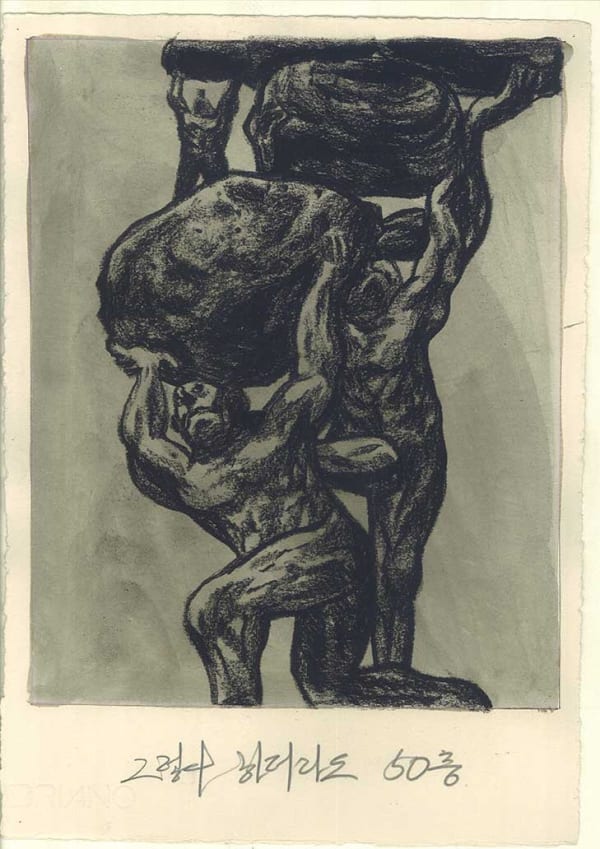Dual Narrative: Bae Yoon Hwan, Shin Yong Jae
Chapter II is pleased to announce a two-person show, Dual Narrative: Standing on The Horizon by Bae Yoon Hwan and Shin Yong Jae from 8th June to 15th July.
The horizon symbolically plays a crucial role as a standard point of the phenomenal world. On each significant occasion of the history of civilization such as the Age of Discovery emerged in Europe as the centre, the exploration of the African and American continents and opening up the Silk Road, the horizon operated as a source of information that mankind would relies on. As its linguistic origin—the Greek word, ‘horizein’—implies, it was considered as a lower limit of the sky which represents an subject no one can intervene in. On the other hand, the ground that occupies the underneath of the horizon stands for not only an area of human activities and a physical foundation of civilization, but also the root of the phenomenal realm embracing human history, philosophy, ethics, social norms, and even the necessities of life.
In this context, Bae Yoon Hwan’s drawing series densely unfolds numerous scenes occurred by various groups of people and different styles of creatures who sprang out of his imagination. Adopting the form of Candid Photography, he depicts great diversity in incidents of main characters thrown into social rules, hierarchy, desire, entertainment, logics and absurdity. Combined with their titles roughly given on the bottom of the works, these images reveal ambiguous sceneries devoid of precise spatial-temporal datas and asituational description.
He stages bizarre and unfamiliar images in his work by employing bold techniques, and it consequently allows spectators to speculate about his storytelling mechanism of the period when he was building his own illusionistic approach. Bae Yoon Hwan obtains his motifs through personal experiences, tales, narratives, political events which he has encountered; he selectively borrows classical art imageries or media figurations constantly produced for 24 hours and he maintains his working process of juxtaposing and contrasting extensive stories in order to convert them into an endless narrative. Hence, sporadic and anecdotal stories irregularly exist in his practice, instead of remaining in an designated certain storyline. This is Bae Yoon Hwan’s distinct interpretation of figurative art’s Automatism.
Shin Yong Jae’s ‘Remembrances of A Stage’ series is a succession of documentary paintings which describes external features of the sky. The sky is an unalterable natural subject and also the horizon’s upper part which signifies an antipode to Bae Yoon Hwan’s drawing series. Shin Yong Jae attempts to establish invisible layers which exist only in his thoughts by accumulating his sentiments, affairs and attitudes occurred in his daily life onto the sky landscape which is broadly understood as a symbolic leitmotif of fine art, rather than taking an exclusive stance of detaching himself from the space where is separated from the terrestrial world. (These invisible layers practically share a similar aim with Bae Yoon Hwan’s drawings whose direct expression unveils innumerable aspects of human life, yet in terms of the appearance, they are more reserved, refined and restrained.)
Even though there is a risk in which a representation of the sky scene can be seen as a conventional and banal subject matter, Shin Yong Jae’s work does not stay in a static landscape; it eventually attains its individuality as he covers it with his immaterial reflection on a trivial routine connected to a specific time and space. A wide range of weather shifts could demonstrate the artist’s psychological changes of each day or it could be the certain day’s observation of his own inner side exposed by the artist who deals with the subject through an act of painting. The main agent of the identification is not the artist; it is the sky—the independent entity above the horizon. Nevertheless, the artist acquires a position of the painting’s host by selecting particular sections or overall conditions of the sky and furthermore, by applying subjective analyzations on the colour emission.
-
 Bae Yoon Hwan, Even So, 50th Floor, 2012
Bae Yoon Hwan, Even So, 50th Floor, 2012 -
 Bae Yoon Hwan, I Like That Prison, 2012
Bae Yoon Hwan, I Like That Prison, 2012 -
 Bae Yoon Hwan, People Who build Prisons in Piranesi, 2012
Bae Yoon Hwan, People Who build Prisons in Piranesi, 2012 -
 Bae Yoon Hwan, The Answers Missed, 2012
Bae Yoon Hwan, The Answers Missed, 2012 -
 Shin Yong Jae, Memory of the Stage, 2016
Shin Yong Jae, Memory of the Stage, 2016 -
 Shin Yong Jae, Memory of the Stage, 2016
Shin Yong Jae, Memory of the Stage, 2016 -
 Shin Yong Jae, Memory of the Stage, 2016
Shin Yong Jae, Memory of the Stage, 2016 -
 Shin Yong Jae, Memory of the Stage, 2016
Shin Yong Jae, Memory of the Stage, 2016











